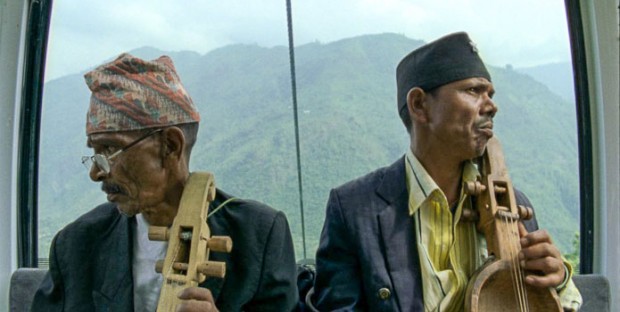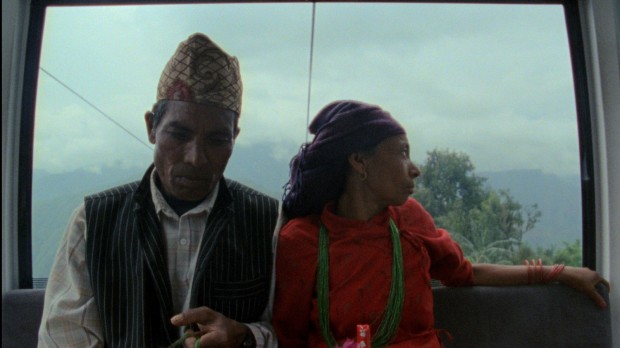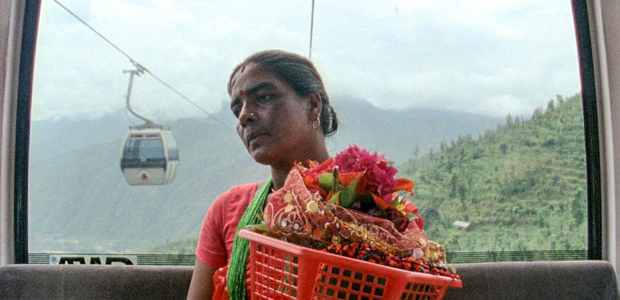First image: absolute darkness. We hear the sounds of mechanical contraptions and can see small flashes of light. We’re inside a huge structure, but what causes this ruckus is impossible to decipher. Eventually, proper illumination creates the shape of two figures just in front of the camera, a bright sky behind them. The camera is pushed forward, and what had seemed abstract comes into full detail: an old man and a young boy, perhaps a grandfather and grandson, sitting calmly as a window behind them displays the forest which they will soon rise above. This container they sit in is a trolley, the vehicle reaching further and further above the ground, passing up and up through what seems to be an endless number of hills. Both sit silently, neither acknowledging a camera nor turning around to take notice of the fantastic sights that pass by. Yet we, the viewer, are on a thrill ride.
Stephanie Spray and Pacho Velez’s Manakamana, the latest work from the Sensory Ethnography Lab at Harvard — most recently behind Leviathan, a TIFF entry last year — is a spellbinding work of humanist cinema, and a rigorous experimental documentary that allows its viewers to breathe inside a unique landscape resting somewhere between nature and technology. If Leviathan did everything in its power to bring us light years from a human experience of the world, Manakamana is our species at its most intimate. The passengers “act” to a stationary camera, which observes their interactions directly, cogently, and, often, delightfully. It’s a tightrope act — in many ways, far more carefully parsed together than the looser structure of Leviathan — but Spray and Velez conceive a travelogue in the vein of Abbas Kiarostami and avant-garde artist James Benning, one which, through its execution, perhaps solidifies the Lab as the most important vanguard trailblazers in contemporary cinema.

Discovering its structural design is part of the fun, and, while it’d be a shame to spoil exactly what happens in Manakamana, it’s nevertheless necessary to investigate aspects of this work, considering the means through which it communicates to an audience. The title comes from a temple high above the mountains in Nepal, far from any “modern” society that we can see. As one woman remarks to her husband while on the trolley, a journey might have taken three days, by foot, before the cable car connected either end of the mountain. Spray and Velez present eleven long takes, each lasting the duration of the trip up or down — Manakamana‘s first half covers journeys up the mountain, while the second half journeys down — though proceedings are strung together as if all happened on the same day and, to several extents, in the same cable car. (An interview I read after seeing the film noted that its shots were collected over a year.)
Part of the interest to be found in Leviathan was how its directors created such a work, inspiring the sort of “how did they do that?” questions which can overtake film discussion too easily. Thankfully, there’s no mystery as to how Spray and Velez have filmed Manakamana: the camera is simply stationary, staring directly at its performers. But it is also a case of creating an “un-directed” cinema as Leviathan; there’s no directors present in the trolley, simply the camera recording and capturing interactions between these passengers with their environment swirling around them. (Unlike Leviathan’s use of GoPro cameras, Spray and Velez shot on 16mm.) The shots themselves, save for one humorous ride best not spoiled, are set up in a way that acknowledges its own “cinema”; the frame itself is designed so that the window behind riders bears an appearance quite similar to a cinema screen, and, because we can only see what is in the window behind them, the ride in question could have easily been some virtual reality display. During the first few trips, when trolleys pass by one of the large structures that connect the traveling lines, a thunderous shake would quickly, suddenly rattle through the soundtrack, giving me a huge jolt in my seat — but, eventually, like these calm passengers, one becomes acclimated to this process.

What truly separates Spray and Velez’s approach from Leviathan is that this is a very created work, tightly structured in terms of who is being presented in each of its mini-narratives. (In certain respects, documentary seems a very wrong word to describe the effort.) The first two rides are completely silent, allowing us to take in the views behind us while contemplating why each person makes the trip they are making. But, from there, the performers become more and more engaging, and the echoes between them ring more and more clearly. There’s an early scene in which a middle-aged woman, riding to the top for a prayer ceremony, remarks, to her husband, about a constantly popping ear; this is mirrored later when one of three young tourists, taking “selfies” and talking about their bands, notes that his ears keep popping as well. These small reflections make for something of a humanist reflection in the strange world of the trolley; despite the numerous cultural and generational divides, everyone shares the same feelings in this journey.
Considering the setting and environment at hand, another filmmaker might view the employed technology with disparaging eyes. Manakamana, however, is staunchly welcoming toward the meshing of mechanical wonderment and the nature around it: as one elderly woman says to her friends, “After what we’ve been though, these days are better,” all while taking in the sights and comforted to know they’re able to experience this world through this system. While the trolley may act as something of a barrier between those who ride and the villagers below –“What did they say?” is what one passenger remarks to his friend as they pass by a village; the other replies, “Who knows?” — Spray and Velez have an ultimately optimistic view of this space as one where anything can happen, including a truly delightful musical performance. It could hardly be called an ethnographical study — we learn little of the culture or the goddess that inhabits the temple — but is closer, rather, to a work like Kiarostami’s Life, or Nothing More…, in which we simply experience the details of human existence, minus any true commitment to narrative.
It’s hard to describe the passions and joys that Manakamana manages to cohere while celebrating its world. Who’d guess that perhaps the year’s funniest, most exhilarating, and most touching scene would simply involve an elderly woman rushing to finish a melting ice cream bar? In a year where so many works of documentary cinema — and, even, avant-garde works — attempt to express ideas about our culture through grand gestures and themes, Spray and Velez use the everyday to create a masterful, celebratory work about human experience in the 21st Century.
Manakamana screens at TIFF on September 6th, 8th and 15th. Watch the trailer above and click below for our complete coverage.


